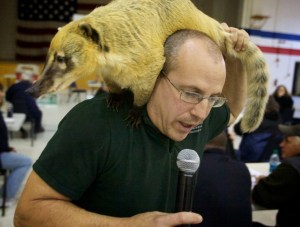Several years ago, he recalled Thursday, an oil delivery driver heard an unusual pounding sound from a residence. Thinking the elderly woman who lived there may have fallen and been unable to summon help, he contacted public safety officers.
The pounding, it turned out, was coming from a closet, where Strout and others found a small cage containing a monkey. Gesturing to indicate the animal was about the size of a 5-gallon bucket, Strout said the cage wasn’t much bigger than the animal.
“And it was vicious,” he said.
Some 25 years earlier, a friend of the woman’s husband had run a zoo in Durham, and when it closed, gave the monkey to the husband. When her husband died, the woman didn’t know what to do with the animal, and so kept it in the cage in the closet. The animal control officer took the monkey away from her.
Strout was joined by about 80 other animal control officers from around the state on Thursday in the Augusta Armory to learn more about the sorts of exotic animals that are showing up in Maine, legally and otherwise.
The training session was hosted by the state Department of Agriculture’s Animal Welfare Program, and featured a presentation by The W.I.L.D. Center and Zoological Park of New England, based in Rochester, N.H. The center rescues exotic animals and ends up adopting others.
Among the critters the center’s Executive Director Derek Small and Nicole Monkiewicz, a curator, ushered out of crates and cages were a Bennett’s wallaby, a s erval cat, a hedgehog, a coatimundi, snakes, and yes, a monkey.
Though many of the program participants were smiling at and photographing the animals as they were led or carried around the room, the consequences of dealing with exotic animals are very serious, Small and others stressed. Animal control officers will increasingly come into contact with exotic animals, they said, as purchasing them becomes easier through online sources.
Among recent incidents in Maine involving encounters with non-native creatures were a leopard that escaped from a zoo in Trenton in 2004, a wolf hybrid that got away from its owner in Calais in 2002, a 3-foot alligator confiscated from a home in Monticello in 2008, and a 5-foot-long viper found in Saco in 2010.
“In Maine, you can own almost any species,” Monkiewicz, a graduate of Unity College said, “but you must obtain a permit.” Most permits are issued by the state Department of Inland Fisheries and Wildlife.
From 1990 to 2011 in the U.S., she said, 75 deaths were attributed to people coming into contact with exotic species. Big cats, such as tigers, are the top culprit. In fact, there are 5,000-7,000 tigers kept as pets, more than live in the wild.
Three years ago, a high-profile incident in Connecticut resulted in a chimpanzee’s owner having her face bitten off. The 200-pound animal slept in the same bed as its owner, Monkiewicz said.
“They make us a little nervous to work with,” she said.
Another high-profile case that regulators worry may be repeated was the infamous Ohio Zanesville Zoo incident of 2011, when the owner of the private facility set the animals loose.
The black market for exotic animals is the third largest in the U.S., behind only drugs and guns, Small said.
Kyeema, the center’s Bennett’s wallaby, was the first to be displayed Thursday. Maine officials know of three wallabies now in the state, so animal control officers may encounter them unexpectedly.
“They are flight-based animals,” Small said, and so will likely run if encountered. Demonstrating with Kyeema, he said they can be picked up by the tail.
“They do need to be outside,” he said, in an enclosed area of at least 50 by 20 feet. Fences should have curved corners, Small said, because the wallabies often run into walls and break their necks. Shelter should be available with a heat source for the winter, he said.
Animal control officers should “walk up slowly with arms extended,” Monkiewicz said to take wallabies into custody.
The serval cat, illegal in Maine without a permit, is a hybrid of the African serval and a domestic cat. The half-breeds can stand on their hind legs and put their front legs on a man’s shoulders and look him in the eye, Small said.
Isis, the hybrid who was walked around the Armory, would never be mistaken for a domestic cat, though Small said subsequent generations diminish the long legs and leopardlike spots.
Miguel the coatimundi — an animal very much like a raccoon — “was found roaming the streets of Nashua, N.H.,” Small said.
Liam Hughes, director of the Agriculture Department’s Animal Welfare Program, said the training was an important step in providing animal control officers “with the best possible information for when they come into contact with these animals.”

Comments are no longer available on this story